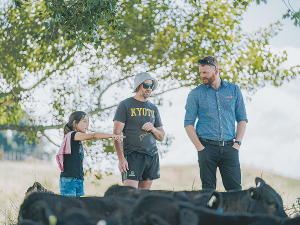Salmonellosis Surge: MPI reports rising cases in New Zealand cattle
Salmonellosis is a serious disease in cattle.
 Waikato dairy farmer Cole Townsend (middle) lifts performance of calves and cows, improving health and production.
Waikato dairy farmer Cole Townsend (middle) lifts performance of calves and cows, improving health and production.
In 2018, faced with a Salmonella outbreak among his calves and the effects of the subsequent vaccination, Waikato dairy farmer Cole Townsend turned to social media for a solution.
Witnessing his calves’ poor recovery and lack of desire to drink, he administered Probiotic Revolution’s probiotic additive Calf Xtreme. Within days, the calves recovered, surpassing his expectations in just 30 days to become the healthiest batch he had ever reared, Townsend claims.
Since then, Townsend has integrated the product into his yearly calf-rearing routine, using higher rates of milk than he had ever used.
Townsend says recognising the importance of a strong start for his calves, he administers BioRescue paste initially, followed by a gradual increase in milk on once a day feeding, to 7-8 litres by day 10.
The results have been remarkable, he says, effectively eliminating nutritional scours and helping Townsend decide he didn’t need to vaccinate the herd for Rotavirus, easily offsetting the cost of the product.
“Calf losses are negligible, heifer calves reach target weaning weights two weeks earlier and by calving they are 20-30kg heavier. There has also been a significant turnaround in fertility of first-calving heifers with empties falling to 3-4%,” he says.
Emboldened by these successes, Townsend ventured further, introducing SuperStart Lead Feed for springers in 2019 and Rumicell for milkers in January 2020. These innovations aimed at enhancing feed conversion efficiency and bolstering herd immunity yielded impressive results. Cows are presenting better at calving.
“We used to assist 10% of the herd whereas now it is only 3-4%. The quality of colostrum is better, there is a rapid increase in milk and cows are getting to peak production 10-14 days earlier,” he says.
Results with mastitis have also been impressive. Cell counts in the first season halved from 120,000 and have generally been below 80,000 ever since. There has also been noticeably less mastitis with annual cases dropping from 15% of herd numbers to 6-7%, except in wet summers.
Townsend says his experience during a drought with the herd on OAD milking provided compelling evidence that daily Rumicell feeding translates into increased milk production.
“Ceasing Rumicell supplementation led to a drop in milk production and a noticeable decline in cow temperament and manure quality. Production lifted again when it was reintroduced. I’m convinced and have been using Rumicell ever since.”
Matt Collier of Probiotic Revolution points out that in the shortterm different herds can respond differently. From a trial done at Lincoln University there was a 22% increase in acetate levels from Rumicell indicating a substantial improvement in feed conversion especially from fibers in the diet.
“We see better rumination and cud chewing because of blood sugars rising, triggering the part of the brain responsible for cud chewing.
While around 50% of herds may experience an initial production boost, factors such as stage of lactation, feed availability and body condition can influence outcomes. Sometimes extra energy is redirected to body condition or when feed is abundant more grass is left behind.
“We like to work with our farmers so that they get a highly profitable outcome.”
Townsend says his journey exemplifies the transformative power of innovative practices and probiotic solutions in dairy farming.
“From overcoming calf ailments to optimising herd health and productivity, each step reflects a commitment to excellence and a willingness to embrace new approaches for sustainable and efficient farming.
“I hope my story serves as a beacon of inspiration for dairy farmers navigating the evolving landscape of agricultural practices and technologies.”
Effective from 1 January 2026, there will be three new grower directors on the board of the Foundation for Arable Research (FAR).
The National Wild Goat Hunting Competition has removed 33,418 wild goats over the past three years.
New Zealand needs a new healthcare model to address rising rates of obesity in rural communities, with the current system leaving many patients unable to access effective treatment or long-term support, warn GPs.
Southland farmers are being urged to put safety first, following a spike in tip offs about risky handling of wind-damaged trees
Third-generation Ashburton dairy farmers TJ and Mark Stewart are no strangers to adapting and evolving.
When American retail giant Cosco came to audit Open Country Dairy’s new butter plant at the Waharoa site and give the green light to supply their American stores, they allowed themselves a week for the exercise.
President Donald Trump’s decision to impose tariffs on imports into the US is doing good things for global trade, according…
Seen a giant cheese roll rolling along Southland’s roads?